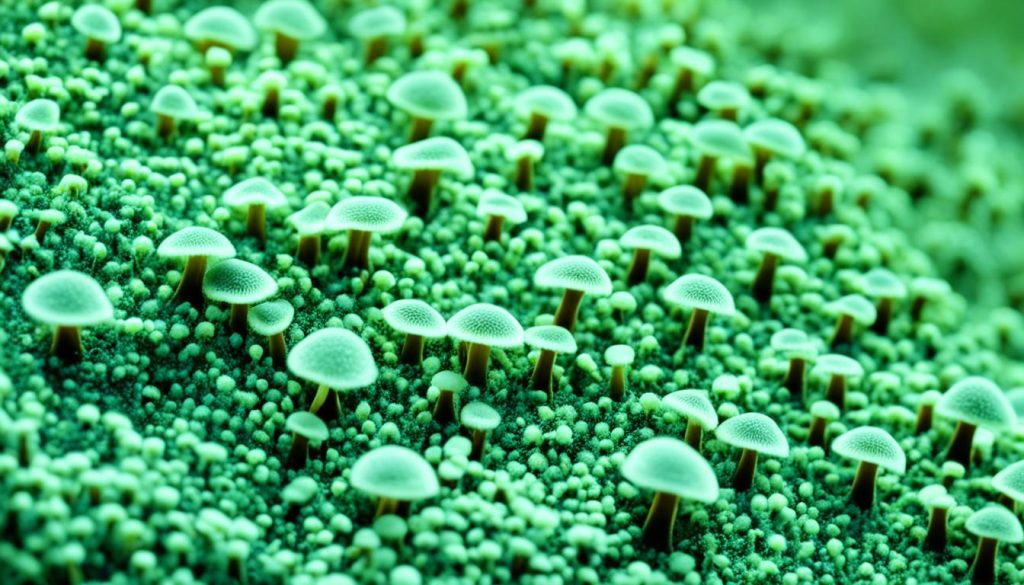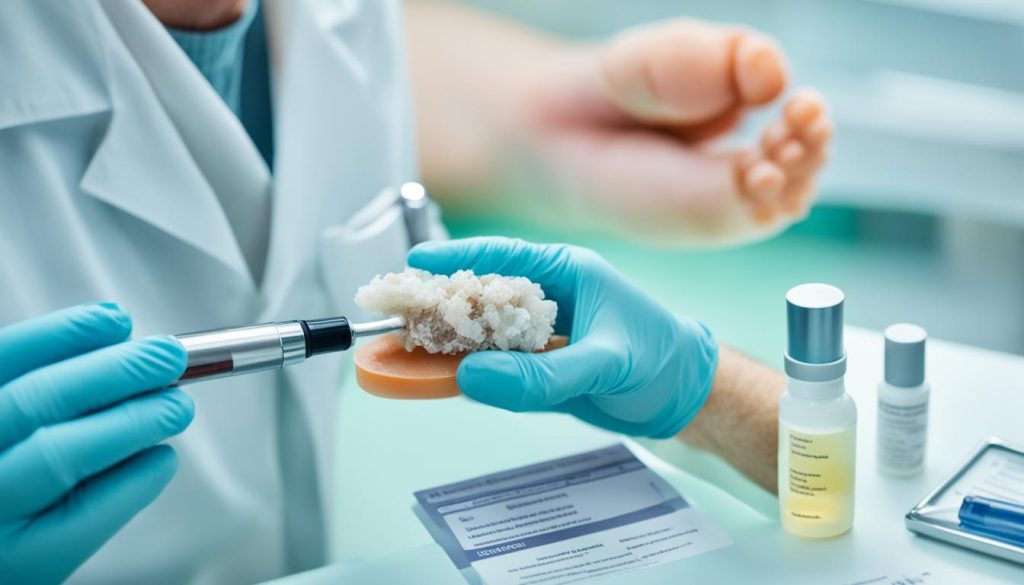Did you know about 10% of people worldwide get nail fungus? It’s shocking how much trouble this infection can cause. Besides looking bad, it can hurt and make nails thick if not treated. Learning how it starts is key to keep your nails healthy.
Key Takeaways:
- Nail fungus affects approximately 10% of the global population.
- Untreated nail fungus can lead to pain and thickened nails.
- Preventive measures are essential in reducing the risk of nail fungus.
- Seeking timely diagnosis and treatment is crucial for effective management.
- Prescription medications are generally the most reliable treatment option.
Symptoms of Nail Fungus
Spotting nail fungus early is key to getting the right help. This condition changes how nails look and feel. Look out for these signs:
- Thickened nails: Nails might get thick, hard to cut, and keep in shape.
- Discolored nails: Nails could turn shades of yellow, green, brown, or black.
- Brittle or crumbly nails: Nails might break easily and become brittle.
- Misshapen nails: Infected nails can lose their normal shape and look odd.
- Nails separated from the nail bed: Sometimes, nails lift away from the skin underneath.
- Foul smell: A bad smell can come from nails with fungus.
What you feel can differ by the fungus type and how bad it is. Early on, you might not notice much. But without care, symptoms get worse, making things more uncomfortable.
Causes and Risk Factors of Nail Fungus
Nail fungus, or onychomycosis, comes from many fungal organisms. The most common ones are dermatophytes. Yeast, bacteria, and molds can also cause nail infections. If there’s a break in the nail or skin, fungus can enter and start to grow. This leads to an infection. Toenails are more often affected than fingernails. This is due to the warm, dark environment feet offer, which fungi love.
There are several risk factors for nail fungus. Getting older is a big one, as older people have weaker immune systems. This makes them more likely to get infections. Health issues, like diabetes, can also weaken the immune system. This makes it easier for fungal infections to happen.
Having hot and sweaty feet can also cause problems. This is often due to wearing shoes that don’t breathe well. Walking barefoot in places like gyms, pools, and communal showers can increase fungus risk. These areas can easily spread fungal infections.
Being around someone with a fungal infection raises your risk too. Sharing items like towels, socks, and nail tools can spread the fungus. If someone you live with has a fungal infection, you could get it too.
Having athlete’s foot before makes nail fungus more likely. Lastly, nail injuries or surgeries give fungus a chance to enter and infect.

Diagnosis and Treatment of Nail Fungus
If you think you have nail fungus, it’s key to see a healthcare pro. They might look at your nail, run tests, or check a nail piece. This helps them find the best way to treat it.
There are various ways to treat nail fungus, based on how severe it is. Treatment options include:
| Treatment Options | Description |
|---|---|
| Oral Antifungal Medications | Taking antifungal pills can kill the fungus inside your body. Usually, you take these pills for a few months to fully get rid of the infection. |
| Topical Antifungal Creams or Solutions | Putting creams or solutions on your nails fights the fungus on top. You need to apply them regularly to work well. |
| Surgery to Remove Infected Nail | If the infection hurts a lot or the nail is really bad, surgery might be needed. The surgeon takes out the infected nail so a healthy one can grow back. |
| Laser or Photodynamic Therapy | Light treatments or light-activated solutions are new ways to deal with fungus. They use special light to destroy the fungus. |
Talk to a healthcare pro to find the right treatment for you. How long treatment takes varies. It could be a few weeks to months, based on your infection and treatment choice. Following the treatment plan closely helps ensure success.
Getting help early and starting treatment fast are the best ways to beat nail fungus and avoid more problems.

Natural Remedies for Nail Fungus
Prescription meds work best for nail fungus. But some want natural options instead. These methods offer another way to fight nail fungus.
Tea Tree Oil
Tea tree oil is a favorite for treating nail fungus. It stops fungi from growing in nails. Just put a few drops on the nails each day. Keep doing it until you notice changes.
Vinegar Soaks
Vinegar can fight against nail fungus. Mix warm water and apple cider or white vinegar. Soak your nails for 15-20 minutes every day. This soak stops fungi from growing.
Essential Oils
Essential oils like lavender and oregano also help. Lavender oil fights fungus directly on nails. Mix oregano oil with a carrier oil to avoid skin irritation. Essential oils need to be diluted first.
However, these natural methods don’t have strong scientific support. They might help some, but outcomes vary. Talk to a doctor before trying these remedies for nail fungus.
Improving nail care helps too. Keep nails clean, wear airy shoes, and don’t share nail tools. A doctor can offer advice on the best treatment for you.

Conclusion
Nail fungus is a common problem that can affect your fingernails and toenails. It’s important to know the causes and risks to prevent it. Good hygiene practices like keeping nails clean and dry are key. Also, wear shoes that let your feet breathe and don’t share towels or nail tools.
Getting help quickly is important if you get a nail fungus infection. Seeing a healthcare provider early can mean a better chance of managing it well. While there are natural remedies, prescription meds are usually the best way to treat nail fungus.
To keep your nails healthy, take steps to prevent nail fungus. Being proactive helps lower your risk of getting an infection. Remember, it’s better to prevent nail fungus than to treat it.




